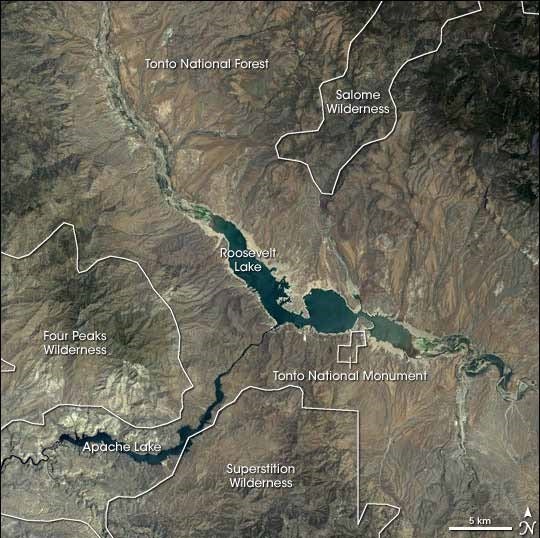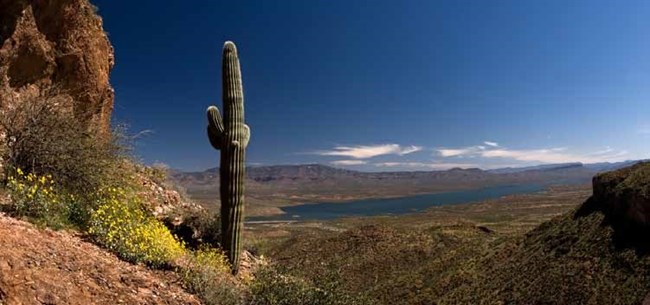
The Tonto Basin lies about 50 miles east of Phoenix, Arizona. The basin is situated in a transition zone separating the upper Sonoran deserts of the Colorado Plateau to the north from the lower Sonoran deserts of the Basin and Range province to the south. Tonto Basin is surrounded by rugged mountain ranges, including the Mogollon Rim to the north, the Sierra Ancha to the east, the Superstition Mountains to the south, and the Mazatzal Mountains north and west. Upper and Lower Tonto BasinTonto Basin is divided into two sections - Upper and Lower. The upper Tonto Basin lies along either side of Tonto Creek north of its confluence with the Salt River. The lower basin lies along the Salt River and modern Lake Roosevelt. The vegetation of the Tonto Basin ranges from desert species in the lower basin to woodlands and forests in the upper elevations. Indigenous animals of the basin include jackrabbit, desert cottontail, mule deer, white-tailed deer, and bighorn sheep. Also, many different kinds of fish, amphibians, reptiles, rodents, carnivores, and birds inhabit the basin. Upper Tonto BasinThe upper basin surrounds the confluence of Tonto Creek and Rye Creek, which are fed by snowmelt and rainfall runoff from the high country north and west of the basin. Vegetation in this area consists mostly of pinyon-juniper woodlands (Clark and Vint 2004), but above 2000 m (6561 ft) in the surrounding mountains, Ponderosa pine, Douglas fir, white fir, quaking aspen, and a few understory shrubs and grasses are also sustained (Van West et al. 2000). Lower Tonto BasinThe lower basin lies along the Salt River at both high and low elevations. Along the river and modern Lake Roosevelt below 1050 m (3450 ft), the vegetation consists primarily of desert plants such as saguaro, cholla, prickly pear and barrel cacti, palo verde trees, ocotillo, and bursage. Prior to the construction of Roosevelt Dam, the Salt River also sustained groves of mesquite, cottonwood, and other riparian vegetation such as willows. Tonto Basin ClimateThe Tonto Basin is a semiarid environment. On average the basin receives between 12” to 15” of yearly precipitation. The majority of precipitation, about 56%, falls during the winter storm season from November to March. The rest of the moisture comes from the monsoon thunderstorms from July to September, with some precipitation in October. Temperatures for the lower Tonto Basin range from an average high of 102 degrees Fahrenheit in July, and an average January low around 37 degrees. The growing season is long, often lasting for more than 300 days of the year. The lower basin would have been perfect for growing corn, squash, beans, cotton and other crops. Irrigation canals drawing from the Salt River were used to water these crops. The upper Tonto Basin climate sees an average high of 102 degrees Fahrenheit in July with the average low in January around 32 degrees. The growing season in the upper basin is shorter than that of the lower basin. 
The Prehistoric EnvironmentThe modern environment and climatic conditions of the Tonto Basin is believed typical of ancient conditions in the basin, with the Salt River and Tonto Creek depositing rich soil on the floodplain and nourishing thick stands of mesquite, black walnut, and sycamore. The area around modern Lake Roosevelt would have been ideal for growing corn, squash, beans, cotton, and other crops, with the potential for double yield in any given year because of the long growing season. Literature CitedAllen, Jesse n.d. NASA image of Tonto National Monument, created using data collected by the University of Maryland’s Global Land Cover Facility June 15, 2000. Original available online at: http://earthobservatory.nasa.gov/ IOTD/view.php?id=5813 |
Last updated: May 24, 2022
